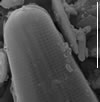Images
Click any image to enlarge...
LM image scalebar = 10 µm = 38 pixels
SEM image scalebar = 1 µm
Observations
| Observations: | Sarah Spaulding and Rhea Esposito |
|---|---|
| Length: | 22-85 µm |
| Width: | 7-13 µm |
| Striae: | 16-22 in 10 µm at the center; 20-26 in 10 µm at the ends |
Description:
Heavily silicified; valve elliptical to linear and often slightly triundulate with a gibbous center and broadly rounded or subcapitate ends. Central area oval shaped. Longitudinal canals present parallel to the raphe. Striae radiate in the middle portion of the valve, parallel or slightly convergent towards the apices. Raphe straight. Proximal raphe ends hooked and variable in termination; some extending past the first or second row of longitudinal striae and others terminating within the central area.
| Morphology: | Naviculoid |
|---|---|
| Distribution: | East Antarctic endemic |
Autecology:
Notes:
By examining separate valves of the same diatom, Spaulding and Stoermer (1997) showed that proximal raphe ends hook to opposite and same sides in approximately equal proportions (1 same: 1.2 opposite, n=58). Distal raphe endings bifurcate and hooked to the same side of the valve as the proximal raphe ends. SEM analysis showed that the valves often (but not always) possess stigma-like "holes" near the hook of the proximal raphe ends, near the terminal raphe ends, and along the distal portion of the valve mantle (Spaulding and Stoermer, 1997, fig. 22, 24, 25). Spaulding and Stoermer (1997) described this species as a member of the recently resurrected genus Muelleria. Many of the larger specimens encountered in this study appeared to have slightly triundulate margins. Futhermore, both Ko-Bayashi (1965) and Kellogg et al. (1980) found smaller valves which were very similar to M. gibbula. In this study, similar valves were encountered which were small and elliptical in shape. In several samples collected in this study, frustules of M. peraustralis were found in varying stages of asexual reproduction. West and West (1911) made the following comments in their original description of the species. " Recent geologial deposit containig subfossil diatoms. This species is similar to those of the N. mesolepta group, but does not agree with any of them. The two lateral areas interrupting the striations are also very characteristic. In general outline it is not unlike N. semicruciata Ehrenb., as figured in A. Schmidt?s Atlas Diat. t. 44, f. 45."
McMurdo Dry Valleys Waterbodies with Muelleria peraustralis
- Adams Stream
- Aiken Creek
- Blue Lake
- Bowles Creek
- Canada Glacier
- Canada Stream
- Commonwealth Glacier
- Commonwealth Stream
- Crescent Stream
- Delta Stream
- Green Creek
- Harnish Creek
- Harnish Creek Tributary
- Huey Creek
- Hughes Glacier Pond
- Lake Fryxell
- Lost Seal Stream
- Many Glaciers Pond
- McKay Creek
- Miers Stream
- Onyx River
- Parera Pond
- Picture Pond
- Pony Lake
- Priscu Stream
- Spaulding Pond
- Taylor Glacier
- Upland Pond
- Von Guerard Stream
- Wales Stream
- Wharton Creek
- Wormherder Creek
Original Type Description
| Author: | West & West 1911 |
|---|---|
| Length: | 47.4 µm |
| Width: | 11 µm |
| Striae: | 18 in 10 µm |
Original Description:
N. parva, valvis anguste lineari-lanceolatis, diametro circiter 4.33 plo longioribus, lateribus triundulatis inflatione mediana majori, polis inflato-capitatis et levissima angularibus, platea centrali parve et elliptica, platea axiali angusta, stiis validis 18 in 10 µm, leviter radiatis, a plateis lateralibus duobus interruptis. Long. 47.4 µm; lat. 11.1 µm.
New combination
| Author: | Spaulding & Stoermer 1997 |
|---|
Citations
Index Nominum Algarum (INA):
- Original
- New Combination
- If an INA link is available, it will be shown above
- The INA is a bibliographic reference "card file" for algal taxonomy, containing nearly 200,000 names of algae (in the broad sense).
Publications (by year):
- West and West 1911. p. 284, pl. 26, fig. 132 [citation 124(105)]
- Ko-Bayashi 1965. p. 1932-36, pl. 1-4. [citation 67(37)]
- Spaulding and Stoermer 1997. p. 101, figs 12-14 [citation 111(97)]
- Spaulding et al. 1999. Phycologia 38:314-341. [citation 126(117)]
- Edlund, M.B. and Spaulding, S.A. 2006. Fossil and Recent Phycological Studies. Pensoft Publishers, Sofia. [citation 134(122)]







